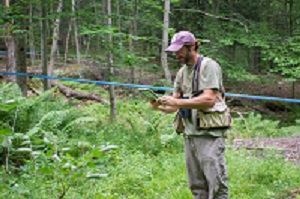
WASHINGTON, Vt. – The Vermont Fish & Wildlife Department and Audubon Vermont are encouraging the state’s maple sugar producers to consider managing their sugarbushes in ways that are beneficial to birds and other wildlife.
“Maple sugaring is an important part of Vermont’s rural, land-based economy and can help provide an economic incentive for maintaining healthy and intact forests,” said Andrea Shortsleeve, habitat biologist for Vermont Fish & Wildlife. “A few simple changes to the way a maple forest is managed can have major benefits to wildlife habitat and there are a variety resources available for landowners who want to learn more.”
Steve Hagenbuch of Audubon Vermont agrees. “All sugarbushes are inherently good for birds because they keep forest as forest. How they are managed however makes all the difference in their ability to provide excellent bird habitat.” Hagenbuch manages Audubon Vermont’s Bird-Friendly Maple Project, a partnership with the Vermont Department of Forests, Parks, and Recreation and Vermont Maple Sugar Maker’s Association, which certifies sugar makers who are employing practices that are beneficial to wildlife.
“Sugarbushes that are managed like a city park -with mature maple trees and nothing growing underneath- may be visually appealing and profitable in the short-term but they support very few birds,” said Hagenbuch. “Conversely, sugarbushes with trees of varied heights and species, as well as brush, downed trees, and standing dead trees, are fantastic places for birds to forage for food, build nests, and raise their young. Additionally, forests managed this way are likely to have better long-term sap production and to be healthier and more resilient to climate change.”
John Buck retired as Vermont Fish & Wildlife’s nongame bird biologist in January after 39 years with the department. He manages his 70-acre sugarbush in Washington, Vermont using bird-friendly forestry methods and produces maple syrup on site in the sugarhouse he and his son built.
“We are very wildlife conscious with our approach to forest management, especially toward all of the bird life here,” said Buck. “Healthy forest bird life is a strong indicator of overall forest health. A healthy forest is essential to the renewable use of the forest for wildlife and for us. In addition to all of the insect-eating songbirds in our woods, we are also benefiting from the hawks and owls who live here too. As these predatory birds prey on red squirrels and other rodents, they help to reduce the pipeline damage that can be very costly to our maple syrup production,”
Sugar makers and other landowners interested in learning more about improving wildlife habitat on their land can contact Andrea Shortsleeve with the Vermont Fish & Wildlife at andrea.shortsleeve@vermont.gov or their local county forester.
For Immediate Release: April 3, 2019
Media Contacts: Andrea Shortsleeve 802-477-2257; Steve Hagenbuch, Audubon VT, 802-233-0332
